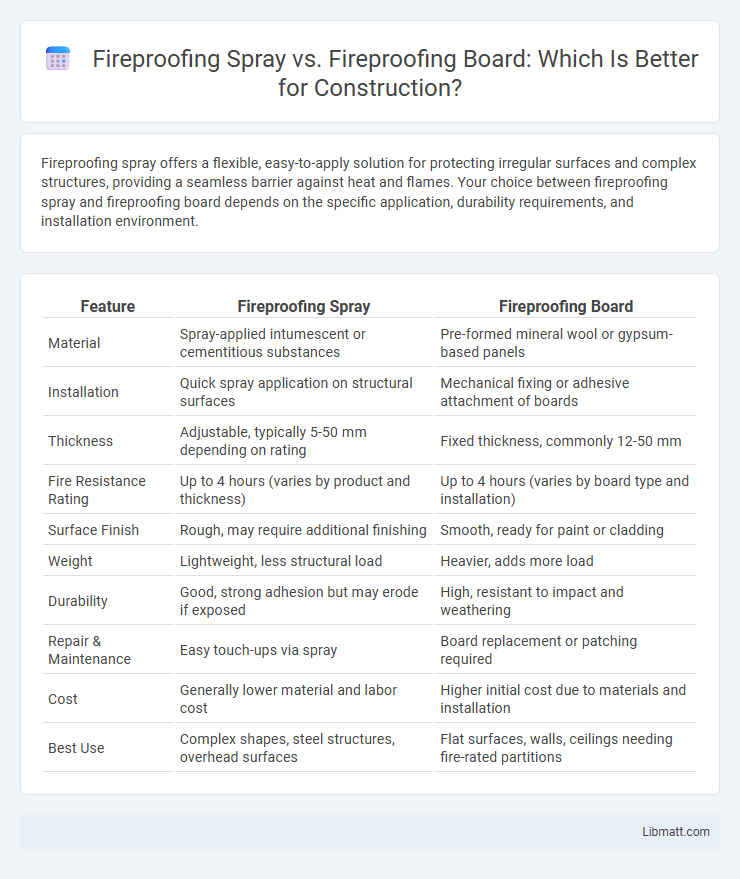Fireproofing spray offers a flexible, easy-to-apply solution for protecting irregular surfaces and complex structures, providing a seamless barrier against heat and flames. Your choice between fireproofing spray and fireproofing board depends on the specific application, durability requirements, and installation environment.
Table of Comparison
| Feature | Fireproofing Spray | Fireproofing Board |
|---|---|---|
| Material | Spray-applied intumescent or cementitious substances | Pre-formed mineral wool or gypsum-based panels |
| Installation | Quick spray application on structural surfaces | Mechanical fixing or adhesive attachment of boards |
| Thickness | Adjustable, typically 5-50 mm depending on rating | Fixed thickness, commonly 12-50 mm |
| Fire Resistance Rating | Up to 4 hours (varies by product and thickness) | Up to 4 hours (varies by board type and installation) |
| Surface Finish | Rough, may require additional finishing | Smooth, ready for paint or cladding |
| Weight | Lightweight, less structural load | Heavier, adds more load |
| Durability | Good, strong adhesion but may erode if exposed | High, resistant to impact and weathering |
| Repair & Maintenance | Easy touch-ups via spray | Board replacement or patching required |
| Cost | Generally lower material and labor cost | Higher initial cost due to materials and installation |
| Best Use | Complex shapes, steel structures, overhead surfaces | Flat surfaces, walls, ceilings needing fire-rated partitions |
Introduction to Fireproofing Methods
Fireproofing spray and fireproofing board are essential passive fire protection methods used to enhance structural fire resistance. Fireproofing spray is applied as a thin, adhesive coating that insulates steel structures, preventing heat transfer during a fire. Fireproofing boards are rigid panels installed on surfaces, providing a stable barrier with higher durability and impact resistance compared to spray methods.
What is Fireproofing Spray?
Fireproofing spray is a fire-resistant coating applied directly to surfaces like steel or wood to enhance their fire protection by forming an insulating barrier. This spray intumesces when exposed to high temperatures, expanding to shield structural materials from heat and delaying fire damage. You can use fireproofing spray for efficient, seamless coverage on irregular shapes and complex structures, making it a flexible option compared to fireproofing boards.
Overview of Fireproofing Boards
Fireproofing boards are rigid panels made from materials such as calcium silicate, cementitious compounds, or mineral fibers, designed to protect structural elements from high temperatures during a fire. These boards provide effective passive fire protection by insulating steel or concrete, maintaining structural integrity, and preventing collapse. When selecting fireproofing solutions, your choice between spray and board depends on factors like installation environment, required fire rating, and surface type.
Key Differences Between Spray and Board Fireproofing
Fireproofing spray offers quick application and conforms easily to complex shapes, creating a seamless protective layer that is often preferred for irregular surfaces and faster project completion. Fireproofing boards provide higher impact resistance and uniform thickness, making them ideal for walls and ceilings where durability and consistent fire protection are critical. Your choice depends on project requirements such as surface type, exposure conditions, and fire resistance rating needed to ensure optimal safety and compliance.
Installation Process: Spray vs. Board
Fireproofing spray offers a quick, seamless application directly onto structural surfaces, allowing for uniform coverage on complex shapes and hard-to-reach areas. Fireproofing boards require precise cutting and fastening to walls or ceilings, demanding more labor-intensive installation and potential challenges ensuring complete coverage around joints. You should consider spray for faster, more adaptable application and boards for controlled thickness and durability where installation time is less critical.
Performance and Efficiency Comparison
Fireproofing spray offers superior adhesion and flexibility, making it ideal for complex shapes and irregular surfaces, while fireproofing boards provide consistent thickness and enhanced structural integrity for flat, load-bearing applications. Spray fireproofing typically requires less installation time and can achieve shorter fire resistance ratings, whereas boards deliver higher fire resistance ratings with long-term durability. Efficiency-wise, sprays minimize material waste and accommodate quick application, whereas boards offer predictable performance with minimal maintenance in high-risk, static environments.
Cost Analysis: Spray vs. Board Solutions
Fireproofing spray typically offers a lower initial cost and faster application compared to fireproofing boards, making it cost-effective for large or irregularly shaped surfaces. Fireproofing boards, while more expensive upfront, provide enhanced durability and consistent protective thickness, often resulting in lower maintenance costs over time. Choosing between spray and board solutions depends on budget constraints, project scale, and long-term fire resistance requirements.
Maintenance and Longevity
Fireproofing spray offers easier maintenance with simple touch-ups and minimal downtime, making it ideal for complex structures where accessibility is limited. Fireproofing boards provide superior longevity and durability, maintaining fire resistance over extended periods with less frequent maintenance needed. Choosing between the two depends on the required fire protection lifespan and the ease of maintaining the installed system in the building environment.
Applications and Best Use Cases
Fireproofing spray is ideal for irregular surfaces, structural steel, and areas requiring quick, seamless application, commonly used in industrial buildings and infrastructure projects. Fireproofing board is best suited for flat, exposed surfaces requiring high durability and thermal insulation, such as walls and ceilings in commercial and residential construction. You should choose spray fireproofing for complex shapes and boards for aesthetically visible or easily maintainable fire protection solutions.
Choosing the Right Fireproofing Method
Fireproofing spray provides a flexible, cost-effective solution ideal for irregular surfaces and quick applications, while fireproofing boards offer higher durability and superior thermal insulation for structural elements requiring long-term protection. Fireproofing boards are preferred in scenarios with exposed steel or areas needing consistent fire resistance over time, whereas sprays suit complex geometries and retrofits. Your choice should consider factors like installation environment, fire rating requirements, and maintenance accessibility to ensure optimal fire protection performance.
Fireproofing spray vs Fireproofing board Infographic

 libmatt.com
libmatt.com